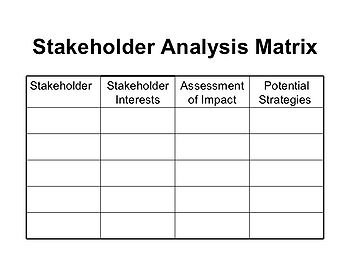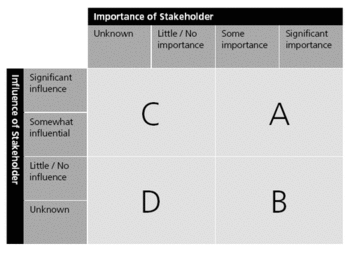Stakeholder Analysis and Matrices
| Line 7: | Line 7: | ||
Freeman <ref>Freeman, R,E. 1984. Strategic Management: A Stakeholder Approach. Boston, MA: Pitman.</ref> published in 1984, ''Strategic Management: A Stakeholder Approach''. It was a landmark of a book and since then there has been many books and articles with the main emphasis on the stakeholder concept. Thomas Donaldson and Lee E. Preston (1995), from Georgetown and Maryland University, has presented three aspects of stakeholder theory. These are as follows: | Freeman <ref>Freeman, R,E. 1984. Strategic Management: A Stakeholder Approach. Boston, MA: Pitman.</ref> published in 1984, ''Strategic Management: A Stakeholder Approach''. It was a landmark of a book and since then there has been many books and articles with the main emphasis on the stakeholder concept. Thomas Donaldson and Lee E. Preston (1995), from Georgetown and Maryland University, has presented three aspects of stakeholder theory. These are as follows: | ||
| − | * Descriptive/empirical theory: When stakeholder theory is descriptive, it means that it presents a model describing what the corporation is. Questions that may arise when working with this theory may be such as: Is the model used by the corporation more descriptive than that of the rival corporation? If so, do observers and practitioners see it that way? <ref>Donaldson, T., and LE Preston. 1995. “The stakeholder theory of the corporation - Concepts, evidence and implications”. Academy of management review 20 (1): 65-91.</ref> | + | * '''Descriptive/empirical theory:''' When stakeholder theory is descriptive, it means that it presents a model describing what the corporation is. Questions that may arise when working with this theory may be such as: Is the model used by the corporation more descriptive than that of the rival corporation? If so, do observers and practitioners see it that way? <ref>Donaldson, T., and LE Preston. 1995. “The stakeholder theory of the corporation - Concepts, evidence and implications”. Academy of management review 20 (1): 65-91.</ref> |
| − | * Instrumental theory: If there is any connection between stakeholder management and the organization, the organization will benefit from taking stakeholders under consideration. | + | * '''Instrumental theory:''' If there is any connection between stakeholder management and the organization, the organization will benefit from taking stakeholders under consideration. |
| − | * Normative theory: The fundamental basis and evaluates why a company/organization should consider their stakeholders. | + | * '''Normative theory:''' The fundamental basis and evaluates why a company/organization should consider their stakeholders. |
Revision as of 12:12, 27 September 2015
Stakeholders are referred to as actors (persons or organizations) with a vested interest in the decision or policy that is being promoted. Stakeholder analysis is the method or process used to identify these actors or key individuals/groups that will have an affect on a project, and how to win them over. Stakeholder analysis allows policy and/or decision makers to interact more effectively with key stakeholders; detect and act to prevent potential misunderstandings about and/or opposition to the policy or program; and increase support for a given policy or program.
Contents |
Background
Freeman [1] published in 1984, Strategic Management: A Stakeholder Approach. It was a landmark of a book and since then there has been many books and articles with the main emphasis on the stakeholder concept. Thomas Donaldson and Lee E. Preston (1995), from Georgetown and Maryland University, has presented three aspects of stakeholder theory. These are as follows:
- Descriptive/empirical theory: When stakeholder theory is descriptive, it means that it presents a model describing what the corporation is. Questions that may arise when working with this theory may be such as: Is the model used by the corporation more descriptive than that of the rival corporation? If so, do observers and practitioners see it that way? [2]
- Instrumental theory: If there is any connection between stakeholder management and the organization, the organization will benefit from taking stakeholders under consideration.
- Normative theory: The fundamental basis and evaluates why a company/organization should consider their stakeholders.
Process
The first and most important thing to do when analyzing your stakeholders is to figure out who your stakeholders are. They are important to your project or policy and they can have an affect (both positive and negative) depending on where your focus is. The next step is to figure out their power, interest and influence. Finally, develop a good understanding of the most important stakeholders. This way you know how they will respond, and how you can win their support. [3]
1. Identify your stakeholders
The use of stakeholders is important to identify which are likely to be affected and which will affect the activity of the organization. In this first step brainstorming is the way to go. Think of all the people that are affected by the work in progress. Who has an interest in it, how has power over it, etc. The table below includes people or organizations that might be stakeholders.
| Possible Stakeholders | |
|---|---|
| Boss | Senior executives |
| Coworkers | Team |
| Shareholders | Alliance partners |
| Suppliers | Lenders |
| Analysts | Future recruits |
| Customers | Prospective customers |
| Governments | Trades associations |
| The press | Interest group |
| The public | The community |
| Family | |
2. Prioritize your stakeholders
Assess how your stakeholders could be impacted or impact upon the organization. The stakeholders that you have figured out will somehow affect your work has to be mapped out. Figure out who wants to hurt you and who wanted to help you. This is done with a stakeholder matrix and described further down.
3. Understand your key stakeholders
Identify your stakeholders 'success criteria' by anticipating the consequences of any change in the organization's activities. How will they feel about any changes in you work? And how can you engage them for a positive outcome? Talk to you stakeholders directly. When being open about thing you build a successful relationship with them.
Limitations
Stakeholder Analysis
The stakeholder analysis can be useful in the way that policymakers and managers can identify key players and assess their knowledge, interest, position, alliance, and importance to the project or policy. By using the analysis, managers can interact more effectively with key stakeholders and increase their support. The stakeholder analysis is conducted before a program is implemented. This allows managers or policymakers to prevent potential misunderstandings about and/or oppositions to the program or policy. [4]
The analysis characterizes stakeholders and provides the information that is needed for a manager to know where his focus should be during the program or policy. The analysis includes the stakeholders’ interests in the project, positions for or against it, potential alliances with other stakeholders, and also their ability to affect the process.[5]
Discussion will include benefits, challenges and uncertainties...
Stakeholder Matrix
The usual method of stakeholder analysis is a stakeholder matrix. Stakeholders are plotted against two variables, importance of stakeholder and influence of stakeholder. In the figure to the left is shown such a matrix divided into four boxes; A, B, C, D.
Box A
These stakeholders have a high degree of influence and they are important to the project at hand. The organization or company has to please this group of stakeholders to ensure their positive support.
Box B
These are stakeholders of high importance to the success of the project, but not some much influence. If their interests are to be protected, they require some initiatives. These groups might be users of a new place, that do not have much voice in the development.
Box C
Stakeholders in this box have a high influence. This means that they can affect the project outcome, but the overall goal is not necessarily aligned with the interests of the right people.
Box D
Stakeholders that are in this box are of low priority and do not require much evaluation or monitoring. [6]
How to make a Stakeholder Analysis Matrix
1. Make a list of all stakeholders
2. Write the name of each stakeholder on a post-it note or index card
3. Rank the stakeholders on a scale of one to five, according to one of the criteria on the matrix, such as ‘interest in the project outcomes’ or ‘interest in the subject’
4. Keeping this ranking for one of the criteria, plot the stakeholders against the other criteria of the matrix. This is where using post-it notes or removable cards are useful
5. Ask the following questions:
- Are there any surprises?
- Which stakeholders do we have the most/least contact with?
- Which stakeholders might we have to make special efforts to ensure engagement? [7]
Discussion
Using stakeholder analysis to come up with a stakeholder matrix is not only a way to provide a clearer understanding of which stakeholders you have, but also how to engage these stakeholders into working in the right direction and towards a mutual goal. Outcomes of a well-planned stakeholder matrix are better project outcomes, and in the long run, better community engagement plans.
Conclusion
References
- ↑ Freeman, R,E. 1984. Strategic Management: A Stakeholder Approach. Boston, MA: Pitman.
- ↑ Donaldson, T., and LE Preston. 1995. “The stakeholder theory of the corporation - Concepts, evidence and implications”. Academy of management review 20 (1): 65-91.
- ↑ The Tool Team (2015)United Kingdom.
- ↑ Schemeer, 1999 "Schemeer, K. (1999). Stakeholder Analysis Guidelines."
- ↑ Raybould, 2009 "Raybould, S. (2009, 07 23). Stakeholder Analysis."Birmingham Metropolitan College
- ↑ Stakeholder Analysis-Stakholder Matrix "Department of Environment and Primary Industries.(2013, 04 26)." The State of Victoria
- ↑ Stakeholder Analysis-Stakholder Matrix "Department of Environment and Primary Industries.(2013, 04 26)." The State of Victoria

